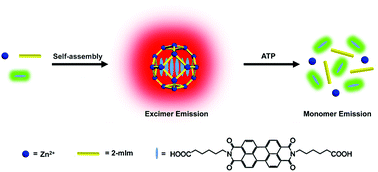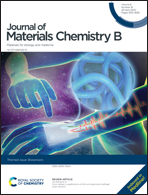Novel perylene probe-encapsulated metal–organic framework nanocomposites for ratiometric fluorescence detection of ATP†
Abstract
Adenosine triphosphate (ATP) plays an important role in various biological processes and the ATP level is closely associated with many diseases. Herein, a novel ratiometric fluorescence assay for ATP was developed based on the excimer-monomer transfer of a perylene probe. By encapsulating a perylene probe, N,N′-bis(6-caproic acid)-3,4:9,10-perylenediimide (PDI), into zeolitic imidazolate framework-8 (ZIF-8) nanocrystals, fluorescent nanocomposites (PDI@ZIF-8) with significant excimer emission of the perylene probe were prepared for the first time. The presence of ATP will trigger the decomposition of PDI@ZIF-8 due to much stronger coordination between ATP and Zn2+ than that of 2-methylimidazole and Zn2+. As a result, the encapsulated PDI probes were released, leading to significantly increased monomer emission accompanying the decrease in the excimer emission. The excimer-monomer transition signal was utilized for ratiometric ATP sensing and its potential application for detecting ATP in cell lysates was also successfully demonstrated.

- This article is part of the themed collection: Biosensors


 Please wait while we load your content...
Please wait while we load your content...